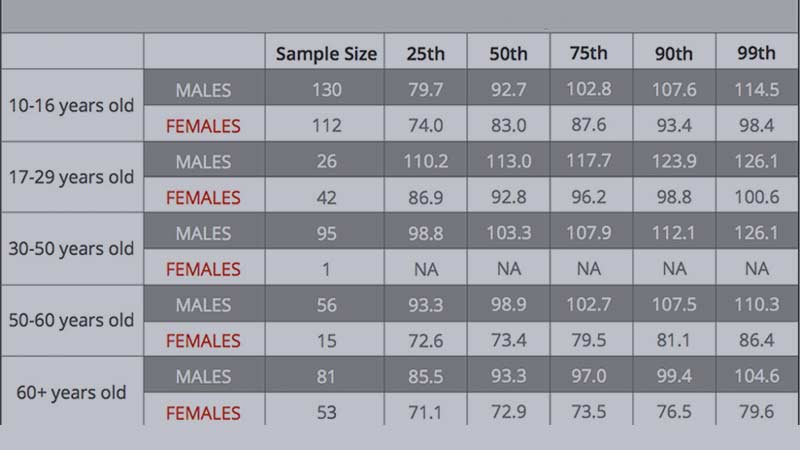The golf swing speed chart serves as a valuable reference, providing insights into the dynamic relationship between age, skill level, and swing speed. Understanding where you fall on this chart is instrumental in tailoring your golf game to optimize performance.
Whether you’re a seasoned golfer or just starting, the chart offers a snapshot of the average swing speeds associated with different age ranges.
This introduction highlights Golf Swing Speed Chart as a tool for self-assessment and improvement, guiding golfers toward personalized strategies to enhance their swing capabilities.
Golf Swing Speed Chart
Creating an actual chart isn’t feasible in this text format, but I can provide you with a simple textual representation of a golf swing speed chart. This chart includes different categories based on swing speed ranges and descriptions
| Swing Speed Range | Description |
| Below 80 mph | Slow swing speed, suitable for beginner golfers. |
| 80-90 mph | Moderate swing speed, typical for recreational golf. |
| 90-100 mph | Average swing speed, suitable for many golfers. |
| 100-110 mph | Above-average swing speed, common for enthusiasts. |
| 110+ mph | High swing speed, often seen in professional players. |
Keep in mind that these categories are generalizations, and individual golfers may fall outside these ranges. It’s essential to consider factors such as skill level, age, and physical condition when assessing swing speed.
Average Golf Swing Speed Chart By Age
Let’s discuss an average golf swing speed chart by age
| Age Range | Average Swing Speed | Description |
| 20-29 | 93-103 mph | Generally peak physical condition, potential for high speed. |
| 30-39 | 90-100 mph | Still maintaining good physical fitness, moderate speed. |
| 40-49 | 87-95 mph | Slight decline in speed due to aging, moderate swing. |
| 50-59 | 82-90 mph | Gradual decrease in speed, emphasizing control. |
| 60-69 | 77-85 mph | Further decline, focus on technique and consistency. |
| 70+ | 72-80 mph | Substantial decrease, emphasis on short game and control. |
These are average swing speeds and may vary widely among individuals based on various factors, including fitness level, flexibility, and golf experience. Golfers should consider these averages as reference points and focus on their own capabilities and improvement goals.
How Do You Improve Where You Fall On The Golf Swing Speed Chart?
Improving your position on the golf swing speed chart involves a combination of physical conditioning, proper technique, and focused training. Regardless of age, golfers can enhance their swing speed through targeted efforts.
Here are seven ways to elevate your standing on the golf swing speed chart:
Strength Training
Engage in a regular strength-training regimen to enhance overall muscle power, emphasizing core, legs, and rotational strength. Improved physical conditioning contributes significantly to increased swing speed.
Flexibility Exercises
Incorporate flexibility exercises into your routine, focusing on the shoulders, hips, and torso. A more flexible body allows for a more extensive and fluid golf swing, potentially boosting swing speed.
Proper Warm-Up Routine
Prioritize a thorough warm-up routine before each round or practice session. A warmed-up body is more responsive, allowing for a fuller range of motion and potentially higher swing speeds.
Golf-Specific Drills
Practice golf-specific drills that target swing mechanics and speed. Work with a golf instructor to identify areas for improvement and tailor drills to address specific aspects of your swing.
Club Fitting
Ensure your golf clubs are properly fitted to your body and swing. Clubs that match your physique and swing characteristics can maximize efficiency, potentially resulting in increased swing speed.
Weight Transfer Focus
Emphasize proper weight transfer during your swing. A well-executed weight shift from backswing to downswing can contribute significantly to the power generated in the swing.
Speed Training Aids
Explore speed training aids designed to enhance your swing velocity. Training tools such as weighted clubs, resistance bands, or specially designed golf training devices can be effective in building strength and speed.
Improving your position on the golf swing speed chart is a holistic process that combines physical fitness, technique refinement, and targeted training.
By incorporating these seven strategies into your golf regimen, you can work towards increasing your swing speed and, consequently, enhancing your overall performance on the golf course.
FAQs
How can I determine my swing speed and where I fall on the chart?
Visit a golf professional or use a launch monitor to measure your swing speed accurately. Once determined, compare it with the relevant age category on the chart.
Can my swing speed change over time?
Yes, factors like fitness, technique improvement, and equipment changes can impact swing speed, causing it to evolve over time.
What does it mean if my swing speed is below the average for my age?
Below-average swing speed may indicate a potential for improvement through focused training, proper equipment, and technique refinement.
How can I increase my swing speed and move up on the chart?
Improving strength and flexibility and employing golf-specific training can contribute to increased swing speed. Consult with a golf professional for personalized guidance.
Is the golf swing speed chart applicable to all skill levels?
While the chart provides general averages, individual skill levels can vary. It’s a useful reference for golfers of all levels to understand their potential and set realistic improvement goals.
Conclusion
The golf swing speed chart is a compass for golfers navigating the intricacies of their game. It offers a comprehensive view of the average swing speeds across various age groups, allowing players to gauge their performance and set realistic improvement goals.
By recognizing where they stand on the chart, golfers can tailor their training, focus on specific aspects of their swing, and work towards achieving higher speeds for better results on the course.
The golf swing speed chart becomes not just a measurement but a roadmap for continual growth and refinement in the pursuit of mastery in the sport.








Colin McCarthy